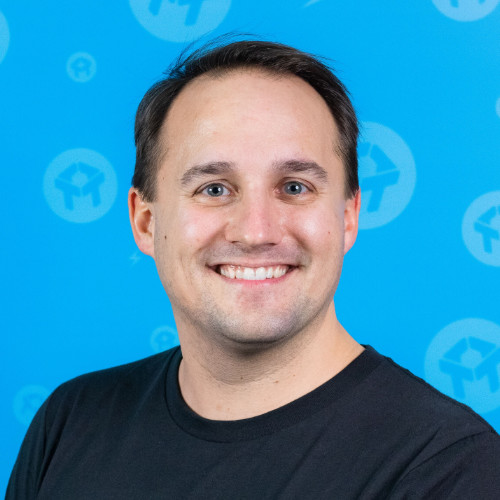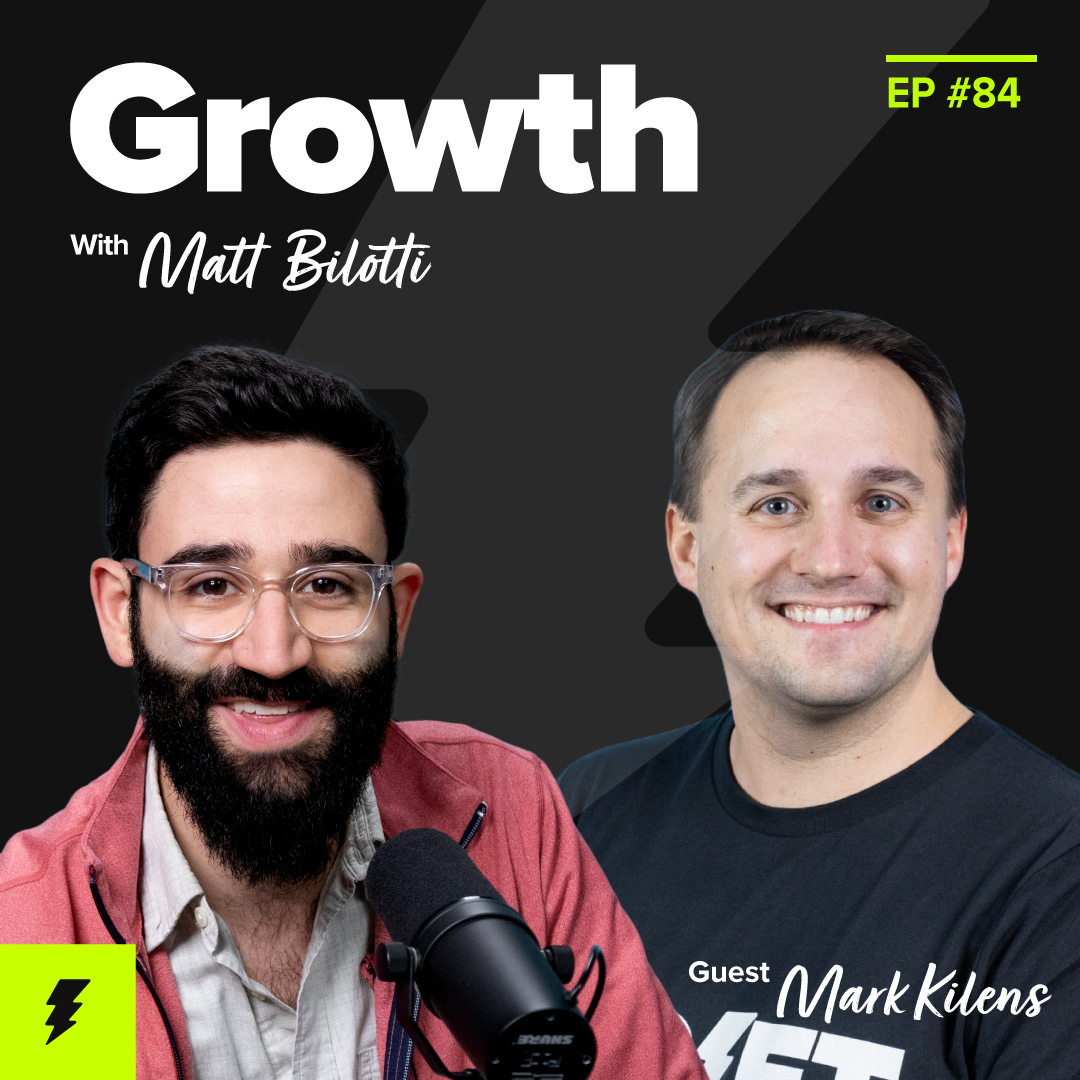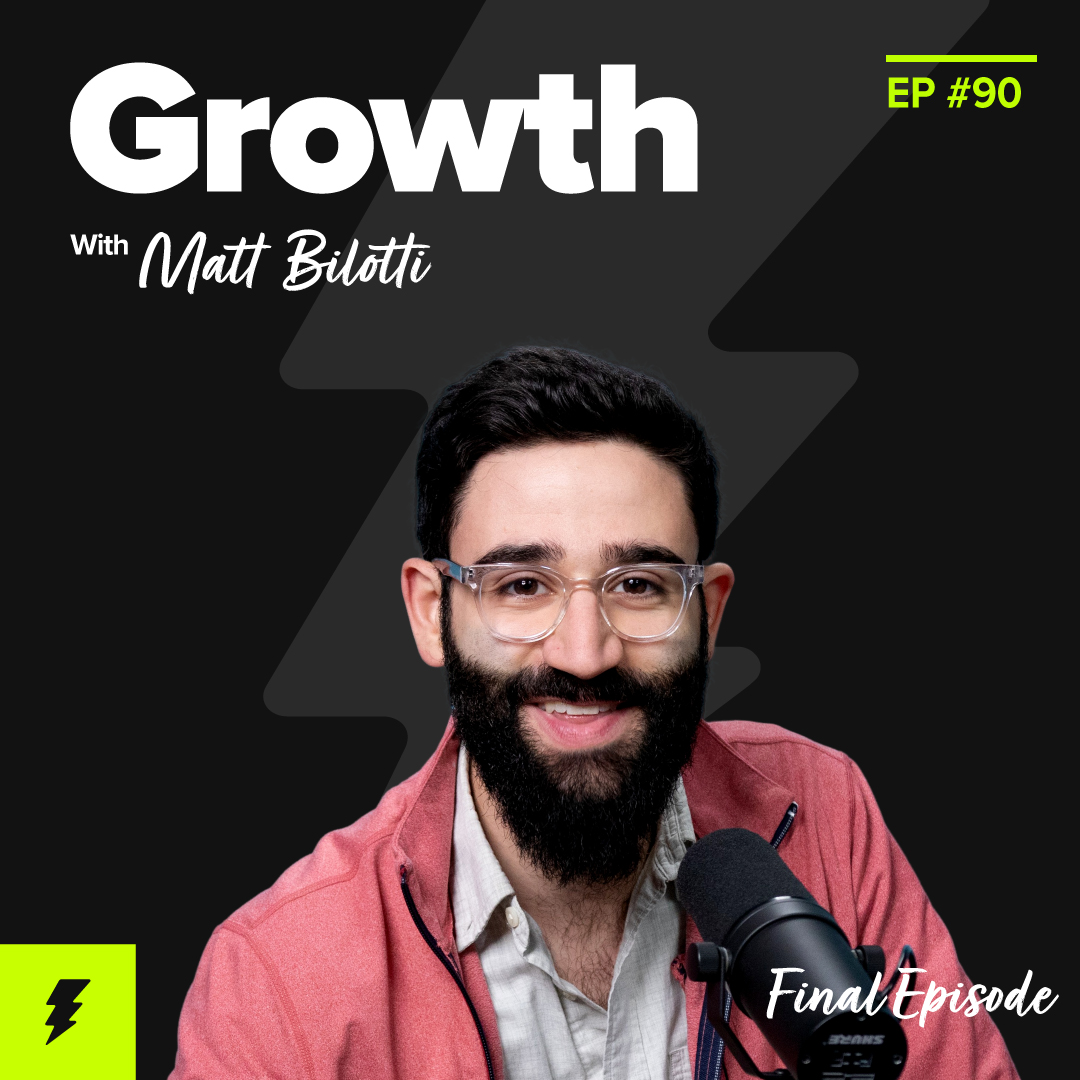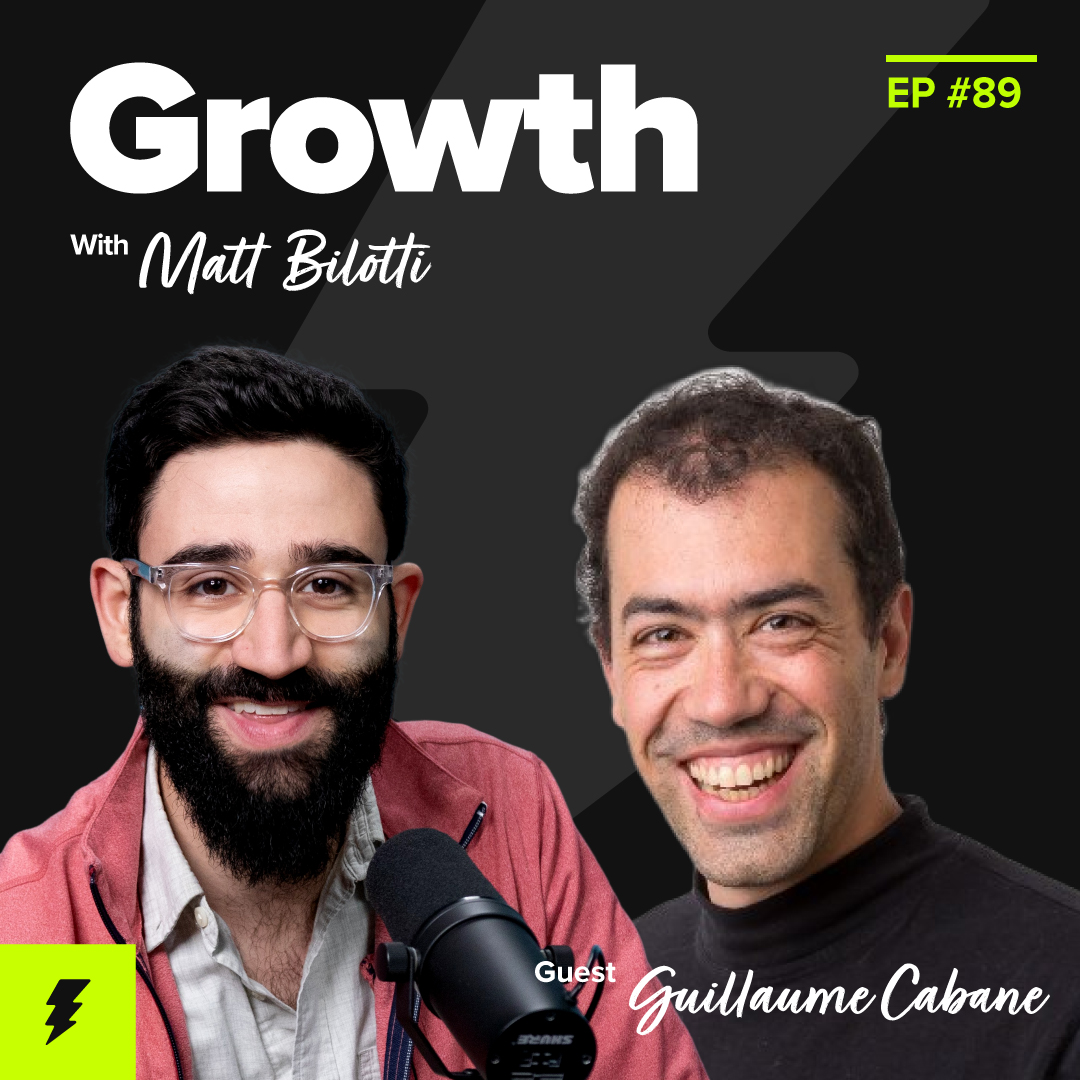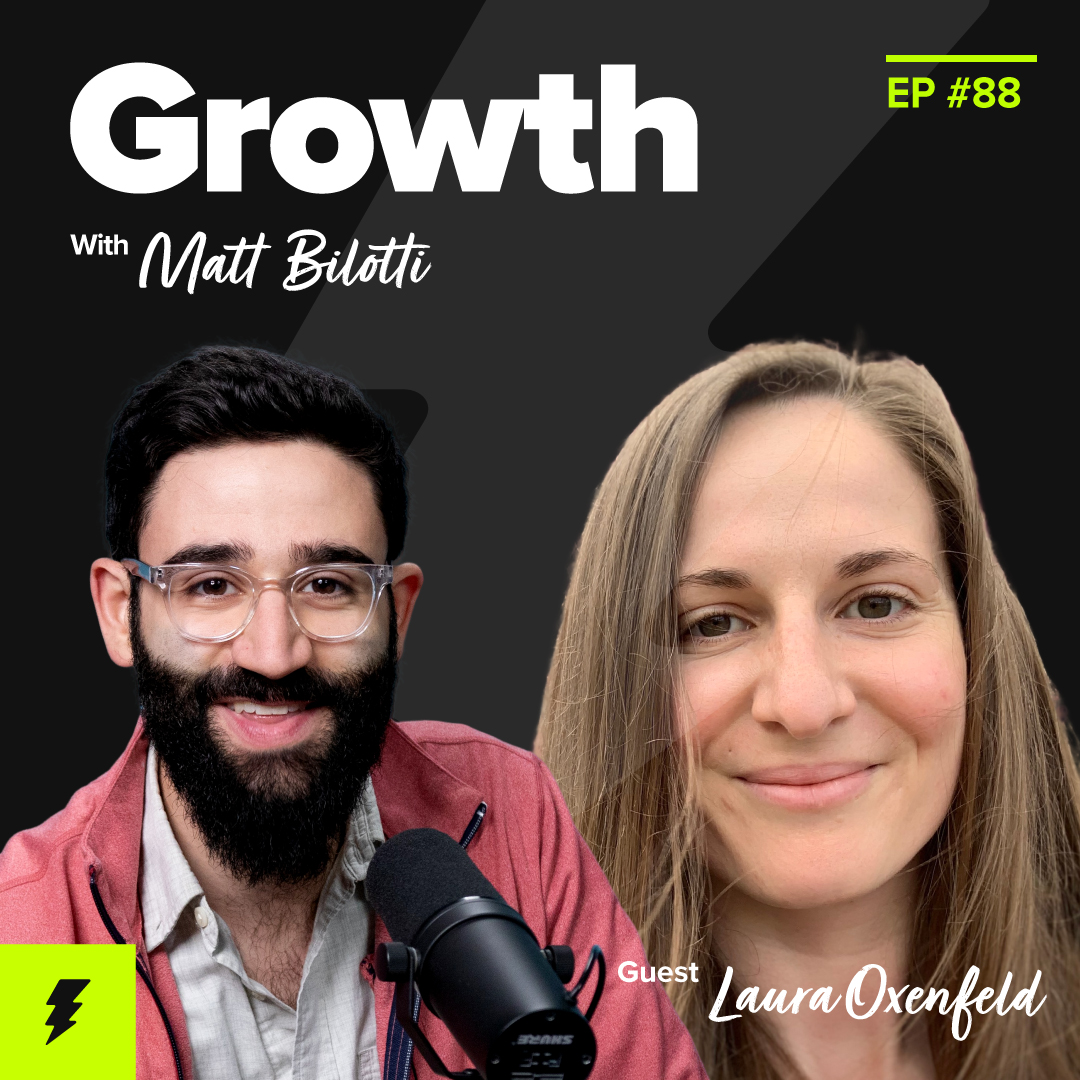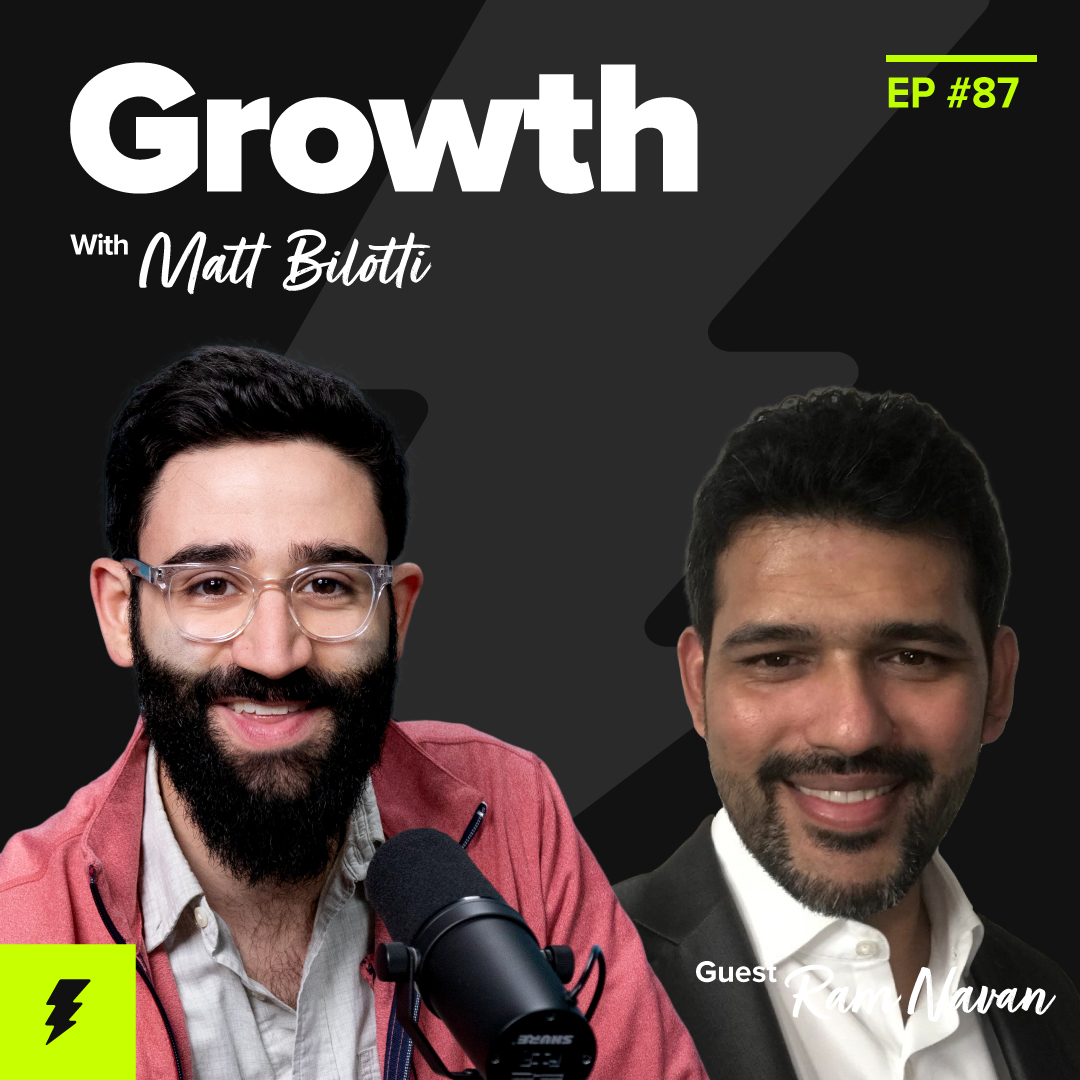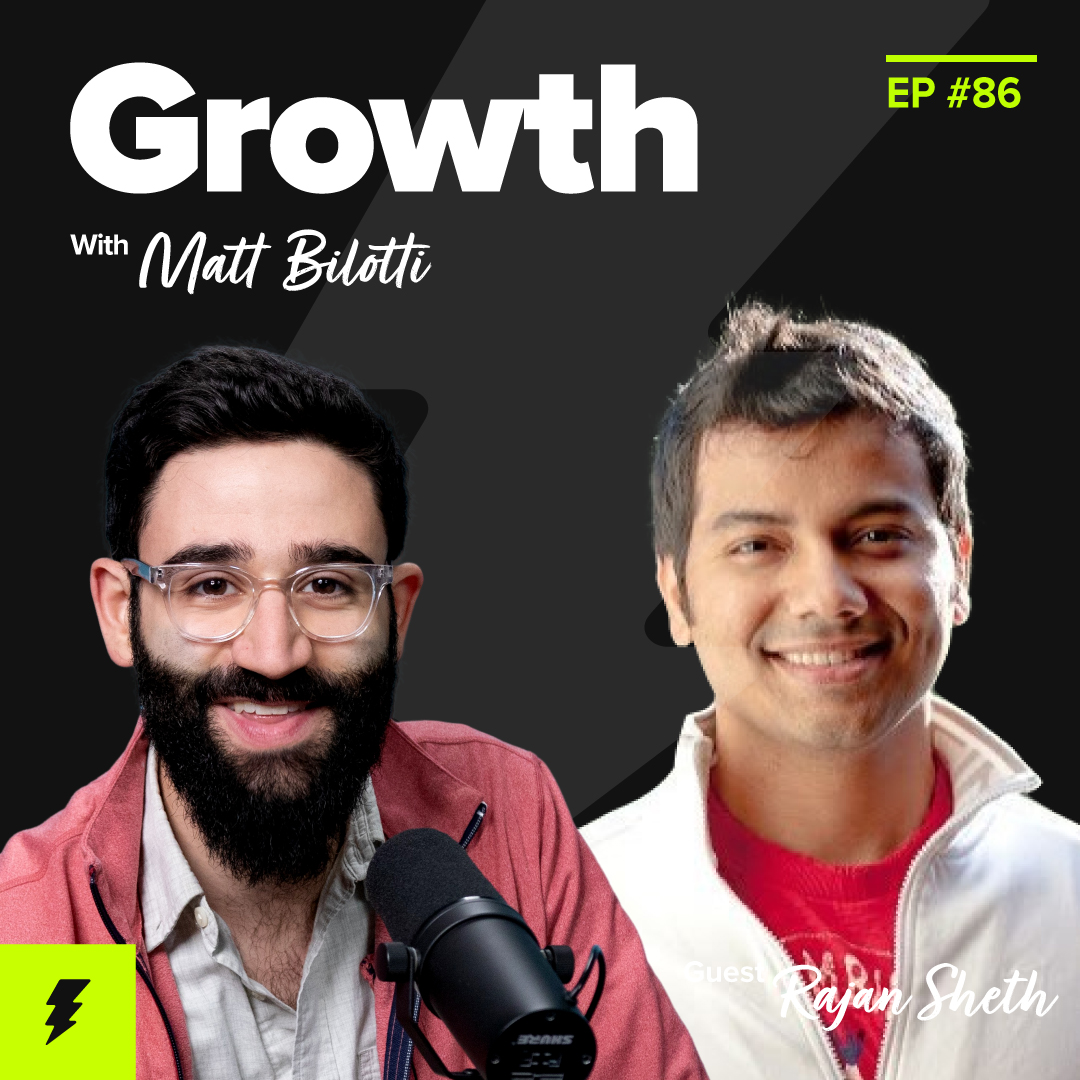Drive Growth through Education (Mark Kilens, Drift)
- 0.5
- 1
- 1.25
- 1.5
- 1.75
- 2
Matt Bilotti: Hello, and welcome to another episode of the Growth Podcast. I'm your host, Matt Bilotti, and I'm really excited today to have one of my colleagues, Mark Kilens. Mark, what's up? Thanks for coming.
Mark Kilens: Matt, thank you for having me on the show. It's a pleasure to be with you today.
Matt Bilotti: That is great to hear. I feel the same. So Mark is a VP of Content and Community here at Drift. We are going to dig into using education as a way to drive growth, building deep wells of content to cross pollinate and drive acquisition. Mark has done this at Drift with Drift Insider, he's done this at HubSpot with HubSpot Academy, and I want to peel back the layers and the strategy behind it, because this is for us, one of the most successful things that we do to drive continual retention and adoption and acquisition and all that fun stuff. And Mark is the master at it. So Mark, I don't know if you got any other quick intro stuff you want to cover before we jump in?
Mark Kilens: No, no, that's fine. Yeah, I've been with Drift for over three years now, was at HubSpot for eight and a half years. Was it a startup before that? But let's dive right in, because what you're talking about Matt is really there's two things to consider when it comes to using education to drive growth. One is product led growth, and I know you talk a lot about that on this podcast. And another one is community led growth and I've seen both and I've been part of both in the past and when it comes to education, first off, like community, in fact, it's a loaded term. What qualifies as education, Matt?
Matt Bilotti: Yeah. That's a good question. Is it blog posts? Is it videos that explain and teach a skill?
Mark Kilens: Yeah, I mean, I educate my audience. I mean, it's almost like table stakes these days. You have to have a unique point of view, if you will, and table stakes in the sense of B2B. I mean, I think it's slightly different in some context of B2C businesses, but in a B2B business, I think of it as a spectrum map, number one. You first have to ask yourself on this spectrum, how transformative is your product? So I'll give you an example, both HubSpot and Drift I think sell pretty transformative products, which requires a lot of education for the buyer and then therefore the customer. So like HubSpot, in bound marketing, new way to think about how to go to market for small/ medium businesses, a lot of new things they had to do. They had to create a lot of content, had to blog, had to think about SEO, had to lean into social. And then now, yes, that has evolved over the last decade, but still there's change management involved. Drift invented conversational marketing. Wait, wait, wait, wait, what is that? What does that require me to do? There's change involved. There's change on the sales side, on the marketing side, to be successful with it, you have to teach people about this. You have to teach them why it matters. Why do it now, how does it work? What products and capabilities should I use? How do I use those products and capabilities within a strategy that works with how I go to market today? Again, I think on the spectrum of transformational type sale, transformational type implementation, both Drift and HubSpot are on the higher end of being transformative. So if you sell a product that isn't as transformative, there might be a different level or different type, whatever you want to call it, education, content required to drive growth. So I'll pause there. Because I think that's a really important thing for people to understand. You have to consider what you're selling, who you're selling it to, how educated already is that buyer in regards to what you're selling them, and what are you asking them to do to then therefore be successful with what you're selling them?
Matt Bilotti: Yeah. It makes a lot of sense. I'm picturing an XY axis and on the X axis, there is how transformative is your sell? How transformative is your product offering? And then on the X axis, it's how much education do you need to offer to make that happen? It's a pretty linear path. The higher the transformativeness of your product, the more you can use and leverage education to help make people successful.
Mark Kilens: Yeah. I like that. I like that a lot. We should graph that out. That's good.
Matt Bilotti: Yeah. I mean, you just said it. I just visualized it.
Mark Kilens: That's good.
Matt Bilotti: So, all right. I'm putting myself in the shoes of somebody listening to this and they are operating in a company with a relatively transformative type offering. There's a decent amount of change management. Maybe they have a free or a trial offering, but there's also a deeply complex part of the product. And they're saying, " All right, this education thing sounds cool. How should I think about it? How should I approach it? Should we just start blogging? Do I need to launch a teaching portal?" How do you start? Where do you go?
Mark Kilens: So I think of it in two ways. One is what do you need to teach at more of the thought leadership side of things? This is a new way of approaching how to solve a problem, or a new way to approach an opportunity. Thought leadership, conversational marketing, tons of thought leadership. We create a ton of educational content and content that's even just more media- centric like podcasts, like this podcast, that is tangentially related to maybe that category, that thought leadership that we've established that will then help attract people that still fit within our overall audience we're going after to then say, " Oh, yeah, I like Drift, that brand. That's cool. That's interesting." And then they slowly get pulled into that thought leadership, that education. And then we can talk about the actual education in terms of thought leadership in a moment, but there's that one. And then the other one is, " You know what? I don't need to spend a ton of time in the thought leadership, which I would argue you do. You still should. There's a degree of how much do you invest in your story, your thought leadership, and I think actually your story and your thought leadership. So your brand story, your belief system and promise, is different than say, your thought leadership. So we can unpack that as well, but you still need to spend time in both. If you sell a product that isn't requiring your customer to change that much, or the customer's already pretty educated, is informed about what you're selling them. So then the second one is the education for the product. And this is where PLG becomes really intersected with using education as a growth driver. So HubSpot, an example, we used a lot of the content that we had in HubSpot Academy in places as part of the product led growth motion, right? So when someone signed up for the CRM, they would get onboarded in specific onboarding places in the product, but also out of the product, such as email marketing communications, things that they might find on Academy or the help center that's self- service based, they would be led, pointed in the direction to this education so that they ultimately get to the point of activation, which is one of the most key metrics for product led growth. It's actually a key metric for community led growth too, and we'll talk about the difference between users and members, I think later. But the whole point is there needed to be a lot of education because you can't... I don't think you can just leave it up to your product to try to get someone to really understand how to use it. You're going to need in some way to activate that product usage through content. I would also say community. A lot of the best product led growth companies, Matt, I think use the power of community forums and that type of motion. Also the best ones use live chat. It's a really scalable way to help someone. This is what we've done done at HubSpot, other companies, can have a live chat agent or a chat bot that's AI- based answer a lot of questions about how to be successful with setting up the product in the beginning. But at the end of the day, a lot of that is based off of education. So you need a team that is thinking about how do we teach someone about how to be successful with this thing, versus teaching someone why they should care, why they should change, which is more the thought leadership stuff. So I'll pause there. I'm just trying to paint the big picture first, before diving in.
Matt Bilotti: Yeah. So on the teach people how to use it, I imagine some people are listening, wondering what is the difference between what you're explaining and help documentation? What is the philosophical difference? Are they the same? Should they be the same? Should they be different? Yeah, tell me about that.
Mark Kilens: No, they definitely can be the same. And they definitely are the same. So for a good example, we do this at Drift, did it at HubSpot, people like to learn differently, of course, different modalities. The simplest way is for the top 20 questions you get, or the top 20 things you need to make sure a new user understands, or maybe not top 20, but a user typically needs to understand a collection of these, these 20 things or the 20 most important. You should have a really well- designed help article and in my opinion, videos to go along with it. And then it's just a matter of okay, how do we use that content in different parts of the experience? But furthermore, if someone really wants to understand not just a point in time, it's like, " Well, how do I set up my fields in a CRM as an example, or how do I build my first playbook?" Those are almost point in time things versus I want to build a playbook that engages my visitors and specifically targets my most important accounts, and I want to make sure my sales people have the ability to act on that engagement and engage in real time or follow up or whatever, versus just build a playbook, which is much more product- centric. So what I'm getting at is you'll want to use this great help article content that you should 100% have and focus on having plus videos, in my opinion, for at least the top 20 or 30. And integrate that into almost a workflow. The education becomes much more sequential. It's like, well, here's why this matters. Always start with the why. You always got to give people context. Here's why it matters, and that could be a 10- second setup, or it could be a few minutes. Here's how you have to think about it, here's how to think about the strategy, and that can be pulling in some of your thought leadership. For Drift, it's like, here's how you should engage your visitors, understand more about them, help them understand more about what your business does and what you can help them do in that moment, and here's how to recommend the next best thing for them. So that's our thought leadership, conversational framework, engagements that I recommend. We can teach that within the context of how to use the product. This is how you create an amazing engagement hook for your playbook. And by the way, here's the help article and video that helps you do that. But you put those pieces together, why, how, what, you can then create a really small even three or four, five- minute container of education that leads someone to that activation point, if you're talking product- led growth.
Matt Bilotti: Love it. So we've covered some of the more tactical types of education. Have we talked about some of the transformative, thought leadership- type education? You just mentioned the conversational framework. From what I've seen, you're a master of all these high level visualizations and understanding how this thing can improve your business, get you better outcomes, but you do it in these ways that people can follow. It's not just a single line, " We do this thing better, use us and it'll be better." But talk about how do you develop the strategy around that thought leadership content?
Mark Kilens: Oh, man. I mean, number one, it's talking to a lot of customers and a lot of people that are smarter than me that are building the product that conceive the idea. Like when I joined Drift, David and I, before I even was officially on the team, he and I were having a lot of conversations like, " How do we unpack what conversational marketing is?" We always try to go down and maybe this isn't the right way to say it, but the notion of first principle thinking. Again, I'm not trying to exactly say this is first principle thinking, but what is the most basic way to think about this so that someone can understand it very quickly? And then the key is, how do you visualize that? Because you have to put a visual to a lot of this stuff, in my opinion. Going back to your visual of that two- by- two, education, need of change, and transformation. So you just spent cycles. It took us about four months to come up with those three words, engage, understand, recommend. And then as part of that discovery process, you have to test it against what your assumptions and what you're trying to get people to do differently today. But then will that hold up as your product changes and will that hold up with your product's vision? For Drift, our vision is to use the power of conversations as the centering thing of everything. Everything starts with a conversation. So if conversations is the vehicle that we're going to use to help someone buy something from a business with a lot less pain, make it a lot easier, whatever, then we have to ask ourselves is engage, understand, recommend the best, most simplest way to think about how to help a business make that change happen? And that's the process we went through. And then well, we said, "Could it be applied to all these different scenarios? Could it be applied to marketing? Is that how a marketer should think? Is that how our salesperson thinks? Is that how our service person thinks? And ultimately what it came down to is if we again said the conversation is the core of everything, we have to ask ourselves then, is that how a conversation happens? Do you engage? You engage someone when you talk to them, there's a level of mutual understanding that typically happens. Or I would argue, it's not a conversation. Maybe it's just more just an argument. And then there's naturally in the conversation some types of recommendations, typically that come out of it. You're sharing something, even if it's just, " Yeah, let's meet up in 20 minutes over there." Ultimately, you're recommending you do something, it's a recommendation. It doesn't have to be like, " Hey, I think we should meet at 3: 00 on Tuesday." But when you're in a conversation with a friend, naturally, truly things would be like, " Yeah, that was awesome. We should do that again." Guess what? " We should do that again," is a form of a recommendation.
Matt Bilotti: Yeah. Okay. So you touched on this a little bit with this thought leadership content around the longevity of it. You want that framework, that context to be built so that it can live on for years. Tell me about how if I'm imagining people getting into this or even looking at examples of what I've seen, I've seen some companies make these sorts of bets on education and then eight to 12 months later, all the content is super outdated, the product visuals aren't the same, the context has changed for their business. Talk to me about how you think about getting that sort of longevity with any sort of content and keeping it up to date over time?
Mark Kilens: It's like the product, like product debt, you have content debt, is that what you call it, Matt?
Matt Bilotti: Yeah. Product debt, tech debt, design debt is now a thing people are saying, so.
Mark Kilens: Yes. Tech debt. I was thinking tech debt. And design debt, I've heard that. So number one thing that I've learned, one of the number one things I've learned over the last many, many years is how important planning is before you start producing. I think it was like, you plan, you produce, you promote, and then it's kind of a cycle. And if you just end up starting to produce a lot of content, you're going to end up without a strategy, without thinking through it well enough, without defining the audience, without defining the promotion plan and how it's going to be used in the customer life cycle. You're going to end up with a lot of content debt, and then a few things will happen. You'll have almost too much content. People will be confused on what they should be reading, where they can find it, you'll be struggling to maintain it. So my number one recommendation is to create, for every type of significant piece of content that you create, this does not include blog articles, but if you're creating a set of educational pieces of content to help people get onboarded with your product, if you're creating and have an example of that, then I can share in a moment, if you're creating your thought leadership ebook that you'll then turn into a course, we did that with the Conversational Marketing Blueprint, and then we have the Conversational Marketing Certification Course.
Matt Bilotti: Perfect.
Mark Kilens: Create a content brief. And I'm not sure what's equivalent to that in the product world, but you need a brief that says, " Here's who we're creating it for, here are the objectives of this piece of content. Here's how we're going to measure success. Here's all these details." And I'm happy to share all this with your audience. We have a great brief template." Here's how it's going to be used, like I said, in the customer life cycle. And here's the level of maintenance that will most likely be required to maintain this piece of content." And that's actually something we could be even better at at Drift. I don't think we take it to that level enough when we think about content briefs. So folks on the content teams listening to this, we need to be doing that more. So we'll start doing that, but that's something we did in the past. In my past, we did that and it's like, " Well, what's the assumption that in six months, knowing some of the product roadmap, knowing some things we know about just content decay, we'll need to update." So that's when you create these pieces of content and then it could be a big piece of content or it could be like, " I'm going to teach someone in seven steps how to do these things. It's going to be seven help articles, seven videos put together in a package that guides someone through this experience." Perfect. Okay. Still have a brief. Your other question though, or your question within that question almost, the bigger question is well, how do you know that the framework or your massive thought leadership thing's going to hold up? That's what you're asking. How do you engage, and understand, recommend? I'm just trying to get a sense.
Matt Bilotti: Yeah. Yeah. How do you make sure that one's going to hold up too, before you anchor everything around it?
Mark Kilens: That is through a lot of customer interviews. So the best product folks, I think Matt, and let me know what you think, talk to a ton of customers.
Matt Bilotti: Yes. True statement.
Mark Kilens: And the best content marketers. So the best product managers, the best content marketing managers talk to a lot of customers. And they don't talk just once. I'm constantly along with my team, Colleen, Sammy, Garry, we're talking to both customer success managers at Drift, our customers to see how engage, understand, recommend is playing out. So here's an example. We're iterating our product right now. We ship all the time and we're having a huge product launch happening specifically around conversational AI. We had to put this to the test, does engage, understand, recommend work for conversational AI? So how do we do that? The content folks have partnered with the product managers and product folks to make that happen. So my simple answer for everyone listening is your content team needs to work very closely with your product team. I learned this in my earliest days of HubSpot, and I will hold that true for the rest of my life. I just don't think that happens often at businesses, they just don't work together as much. They work with maybe other marketing teams or sales teams, but say, " Oh, I should work with the product team?" Yes, because at the end of the day, you have to understand the product vision, the roadmap, what customers are asking for, to then create both the best thought leadership content that doesn't go out of date too soon, and it's the right thought leadership content, and to create the best more bottom of the funnel educational type content. So I'll pause there.
Matt Bilotti: Yeah. No, it totally makes sense. And I want to steer to a different track that we haven't really touched on, which is around a feature of the types of educational content systems that you've created, which are around certification. So if I'm looking at this, and I'm saying, " Great. We want to make a bet in educational content. We are going to anchor in some of our thought leadership stuff. We have a good sense of what type of depth we need to go for the tactical work," how do I think about... Do I add certification? Do I add testing? Do I add that? When does that make sense and why does that make sense?
Mark Kilens: My God, I get this question so much. I do think people, and it's just follow the leader, if you will. So follow HubSpot Academy, maybe in this case. It's like, " Oh, no, you got to have a certification. Now everything's a certification." Like with a lot of these trends. It's just the trends start, and maybe I do have to apologize with some of that, because I do not think everything should be a certification. That is insane. No. One of the ways I think about it is creating a movement. So forget a category. Category is one thing. But I think a movement is bigger than a category. And what I mean by movement is you want people to be championing on your behalf this new way of thinking, this new way of doing something, and in exchange for that, they get some economic benefit. And then these movements become more almost like communities, but ecosystems. I actually think Terminus did this with account- based marketing in a way, 100%. There's many examples of this, in fact. One of the ways that I think you can help speed up the movement flywheel is by creating a way to give people something that says, " I am an inbound marketer. I am a conversational marketer. I am this thing." And then if the brand has a lot of trust and is a respected brand, you can then go off and start to build out other types of content education that to those people that are participating or you are thinking about joining that movement might pull them in. So for example, it's like, HubSpot's like, " Okay, great. Well, a lot of people want to learn a lot more about social media." HubSpot is a trusted source now. We should start to expand outside of just the certifications that we built that were around our movement and category. We should build some others, because we feel like it's going to hold respect in the industry. And the way you do that is by partnering with other organizations to validate your certification, so we haven't done this quite yet at Drift. We're starting to do it with our partner ecosystem program. But at HubSpot, we did this through a massive education partner program. Those certifications are used in I think over 2, 000 schools and universities around the world now. Validation. 200 plus countries have people certified in that stuff, validation. So you can do a certification and just do one certification and it's good and it's not going to maybe spark a movement. And maybe it's more just like, "I want to get people to be educated about this thing and I'm going to keep it free, but I'm not going to do this massive certification program," and I think that's all well and good. Don't overthink it though. Think about what you're trying to do. In that case, you're probably trying to increase the awareness of your thought leadership. So in my opinion, keep the certification free. Don't charge money for it. I don't know. I have big, strong feelings about this, but if you're trying to build a certification course for the admin of your product, that's more technical in nature, that you're spending a lot of money, time, effort building and maintaining because you have to maintain those, much more than just thought leadership types of courses and certifications, then you might want to charge something or include it as part of them buying a professional services package and you get access to this certification and five people at your company have the ability to take it. Then that's fine. But I think you have to think about it in the context of your business' strategy and where you are. Are you trying to build this big movement? What's the category? Goes back to the transformation change management piece. What are all those factors? Look at all those factors. That's what's going to help you decide.
Matt Bilotti: Yeah. I love that. It makes a ton of sense. And I'm looking at the clock here. We only got a few minutes left. One of the questions that I would love to just talk through and hear your thoughts on is around something that you had told me before we jumped on the recording here, which is around the cross- pollination. So thinking about all the folks listening, and they're like, " All right, so I'm going to make this content that's great. I'm going to do some educational stuff, thought leadership, and all that." And one thing that we had talked about earlier was around cross- pollination. How do you get people from the product into the education content, getting people from the education content into the product. How do you think about that sort of cross- pollination? How do you drive it? What are ways, like maybe some tactical ways that people could walk away with and say, " All right, I'm going to go today. I'm going to start to implement some of this stuff?"
Mark Kilens: Yeah, absolutely. It goes back to the comment around product led growth versus community led growth. Product led growth is all about trying to generate a user of your product in my opinion, and get them to stick around, get them to keep using it, get them to the point of activation, and get them to keep using it. And then ideally, get them to share that product, that free thing, maybe they're using it at a low end, in terms of the cost. They bought it, but it's not like spending a ton of money on it, but they bought it. And get them to talk about it. And then if it spreads like wildfire in the organization, if it's that type of product led growth strategy, then it's incredible. For community led growth, it's all about trying to get a member to join and activate that member in the community. So what's the hook for the product lead growth motion? The hook is a feature, a capability. Maybe it's a couple features or capabilities connected together. But that's hooking them in, if you will, with a really strong value statement positioning. La, la, la, product marketing. On community led growth, what's the hook? What do you think the hook is, Matt? I'm going to ask you, what do you think the hook is for community led growth?
Matt Bilotti: Well, one, it's being a part of something. Two, it's having some new knowledge or shared context around a shared interest, that makes me a better member of that community. But the community is beyond.
Mark Kilens: Yeah. I mean, yeah. It could be. It's a good answer, but I'm going to say no, it's not that thing. It's not that crosstalk
Matt Bilotti: Okay, what is it?
Mark Kilens: The hook is content. The hook is you're giving some people some really more valuable content or education, premium if you will, if you become a member. And yeah, then you can pull them into other types of programming around maybe community- esque things and whatever. And have certifications, be part of that membership, have weekly or monthly programming for them, whatever. We used to do that with a monthly live webinar for only members of HubSpot Academy. Whatever, but you're hooking them in with content. Okay, great. So ideally, you have one or two of these motions set up for your business. And I think community led growth, almost any business could do if they're willing to invest the time and have long thinking on how to use content, how to use education, how to use brand building, how do you use media formats to do this. Then it's a matter of saying, " Okay, well, if I have a free product or even a free trial," could just be a free trial, doesn't have to be a pure premium product. How do I best introduce people that become a member to that product? That's where a ton of design tests and experimentation has to happen. We did so much testing on this and they still do to this day, I'm sure. Eric Peter's at HubSpot, which I think you should have on this podcast, I'll make that introduction, is obsessed with or at least he was obsessed with that type of thinking. Not sure exactly what he's working on now, but the point is you want to design in the right moment of content so it doesn't feel like you're just pushing it on someone, but you're saying, " By the way, if you had the ability," I should say, not used, "If you had the ability to do this thing, it would make your life a lot easier." And then you have a really simple call to action that says, " Yeah, we have this thing, it's free. Check it out if you want. Move on." But you're just integrating it into the content and learning experience. And then on the other side with product led growth, if they come in through that door to your business, it's what we talked about before. It's about introducing the fact that yeah, we can help you get set up with this product through some content, some programming, some education, but did you know that if you check out all this member content, then you become a member of Drift Insider, you're going to unlock all of this additional value, and it's completely free as well. And what you're really just trying to do with both those things is yes, get them to come together. But the ultimate metric is just more engagement, more engagement with your product, more engagement with your content, and you can measure that so well today. There's so many tools that allow you to measure engagement, Mixpanel, I'm forgetting... That's a common one that we've used. What are some of these other tools that you can use?
Matt Bilotti: I mean, there's Amplitude, there's all sorts of... Mode if you're doing SQL stuff. Yeah.
Mark Kilens: Yeah. So we've used all those tools. We use that. In HubSpot Academy, we set up I believe it was Amplitude. Don't get me wrong, but it was one of those two. Mixpanel or Amplitude, and we created all these engagement events. So it's like, great. Now you can see what the members are doing. You can see exactly how much through the certification they take. And then all of this data gets fed or could be fed in different ways for different parts of your team, meaning customer success or sales or marketing or product. And if you notice that engagement is increasing with someone, from what I've seen, Matt, then the likelihood that they're going to buy goes up if you just increase. So what's the ultimate goal you're trying to drive? What's the ultimate... maybe not behavior, but goal? In my opinion, it's just more engagement.
Matt Bilotti: Yeah. Yeah. I love it. I've seen it work. It's magical when you could build the content, community, and education and pair it with the product offering and it just becomes this wonderful thing that cross- pollinates and builds on itself. So Mark, it is always a pleasure to have a conversation with you.
Mark Kilens: Yes, it is. It is, and there's some interesting things that we should talk about more long term. Maybe I'll invite someone else. I'm going to invite someone to a podcast for you, so here you go. That's probably a first for you, but on a future episode, we should have maybe some folks who are doing some interesting things with this concept of engage to earn and learn to earn. Very interesting. Goes in with the Web3 stuff that I know you've been starting to talk about. So maybe we do that at some other point too.
Matt Bilotti: Yeah. Yeah. Sounds like a ton of fun. I am in. Well, Mark, thank you again. Really, really appreciate it. For all of you listening, hit the subscribe button, check out the past episodes. There are some amazing, amazing other experts. And we dig into all sorts of growth tactic strategies, channels, all that fun stuff. If you're a fan, leaving a review does quite a lot, so thank you so much in advance for doing so. I know that there are so many things you could be working on, listening to, watching, reading, whatever it is, and you're spending it here listening to this, and I am extremely appreciative of that. Thank you so much for tuning in. I will catch you on the next episode. Bye.
DESCRIPTION
A robust product education strategy is like an onion. It has many layers depending on where the customer is at in their product journey. When done correctly, product education will drive growth for both your customer and your business.
On this episode of Growth, Matt sits down with Mark Kilens, Drift's VP of Content and Community and one of the founding members of both Drift Insider and Hubspot Academy. Matt and Mark discuss how to first approach a product education strategy, the importance of cross-pollination between product teams and content marketing teams, and if certifications should be part of your education strategy.
The Notes:
- (1:46) What qualifies as education?
- (5:03) How to approach an education strategy for the first time
- (9:37) The difference between product education and help documentation
- (13:18) The strategy behind thought-leadership content
- (17:10) The longevity of content
- (22:53) When (and if) you should add certifications into your product education strategy
- (27:29) How to think about cross-pollination between content and product
Like this episode? Leave a review!
Today's Host
Matt Bilotti
Today's Guests
